Modelling Strategies for the Numerical Simulation of the Behaviour of Corroded RC Columns under Cyclic Loads
Abstract
:1. Introduction
2. Reference Experimental Survey
3. FEM Model
3.1. Geometry, Element Assumption and Analysis
3.2. Concrete Modelling
3.3. Steel Reinforcement Modelling
3.3.1. Corroded Rebars of the Experimental Test
3.3.2. Modelling Strategy 1: Reduction of Constitutive Law by Uniform Corrosion
3.3.3. Modelling Strategy 2: Reduction of Constitutive Law by Pitting Corrosion
3.3.4. Modelling Strategy 3: Bar Discretization and Section Reduction
3.3.5. Modelling Strategy 4: Bar Discretization and Morphology-Based Constitutive Law Reduction
3.4. Bond Modelling
3.5. Expectations about Results
- Modelling strategy 1 could be suitable for capturing the ultimate behaviour of the specimen, while for the pre-yield behaviour there could be some differences with the real response, as an average loss mass value is considered and the influence of the corrosion localization is neglected.
- Modelling strategy 2 should underestimate the capacity of the specimen since the degradation relationships for pitting are too severe in the case of uniform corrosion, as for specimen B25.
- Modelling strategy 3 should improve the result of strategy 1 since the section reduction that is modeled is intrinsically a uniform reduction. Furthermore, considering the geometry of the bar along its length and the relative bond degradation, the stresses in the reinforcement and at the concrete interface should be better understood.
- Modelling strategy 4, which is assumed to be the most complete, should provide the best results, in fact, even if the morphological study did not show strong pitting phenomena, the reduction of the constitutive law is still more refined than the section reduction, as the microscopic effects of corrosion on the bars are considered.
- Modelling strategy 1 should overestimate the ultimate behaviour of the experimental test since medium-high pitting factors were detected for the specimen. Furthermore, it is believed that the results related to the post-cracking behaviour could not be able to provide reliable predictions, since average values of loss mass are used.
- Modelling strategy 2 should better fit the experimental response, with particular reference to the ultimate behaviour, since specific regressions for pitting corrosion are used.
- Modelling strategy 3 should not be suitable for pitting. In particular, the numerical solution could diverge from the real one as the pitting factor could be not representative of the actual condition. Indeed, since the assumption on the section reduction is intrinsically uniform and based on the minimum diameter, generally, the rebar area introduced in the numerical model could be lower than the actual one.
- Modelling strategy 4 should provide better results also in the case of pitting corrosion since the evaluation of the loss mass of each section of the bar is calibrated with the morphological model.
4. Results
4.1. Un-Corroded Specimens
4.2. Corroded Specimen
4.2.1. Modelling Strategy 1
4.2.2. Modelling Strategy 2
4.2.3. Modelling Strategy 3
4.2.4. Modelling Strategy 4
5. Discussion
6. Conclusions
Author Contributions
Funding
Institutional Review Board Statement
Informed Consent Statement
Data Availability Statement
Conflicts of Interest
References
- Cairns, J.; Plizzari, G.A.; Du, Y.; Law, D.W.; Franzoni, C. Mechanical properties of corrosion-damaged reinforcement. ACI Mater. J. 2005, 102, 256–264. [Google Scholar]
- Imperatore, S.; Rinaldi, Z. Mechanical behaviour of corroded rebars and influence on the structural response of R/C elements. In Proceedings of the 2nd International Conference on Concrete Repair, Rehabilitation and Retrofitting, Cape Town, South Africa, 24–26 November 2008; CRC Press Balkema: Boca Raton, FL, USA, 2008. [Google Scholar]
- Almusallam, A.A.; Al-Gahtani, A.S.; Aziz, A.R. Effect of reinforcement corrosion on bond strength. Constr. Build. Mater. 1996, 10, 123–129. [Google Scholar] [CrossRef]
- Coronelli, D. Corrosion cracking and bond strength modelling for corroded bars in reinforced concrete. ACI Struct. J. 2002, 99, 267–276. [Google Scholar]
- Prieto, M.; Tanner, P.; Andrade, C. Bond response in structural concrete with corroded steel bars. Experimental results. In Modelling of Corroding Concrete Structures; RILEM Book Series; Springer: Dordrecht, The Netherlands, 2011; Volume 5, pp. 231–241. [Google Scholar]
- Coccia, S.; Imperatore, S.; Rinaldi, Z. Influence of corrosion on the bond strength of steel rebars in concrete. Mater. Struct. 2016, 49, 537–551. [Google Scholar] [CrossRef]
- Rodriguez, J.; Ortega, L.; Casal, J.; Diez, J.M. Assessing structural conditions of concrete structures with corroded reinforcement. In Proceedings of the International Conference on Concrete in the Service of Mankind, Dundee, UK, 24–26 June 1996. [Google Scholar]
- Cairns, J. Assessment of effects of reinforcement corrosion on residual strength of deteriorating concrete structures. In Proceedings of the First International Conference on Behaviour of Damaged Structures, Rio de Janeiro, Brazil, May 1998; Federal University of Fluminense: Niteroi, Brazil, 1998. [Google Scholar]
- Castel, A.; Francois, R.; Arligue, G. Mechanical behaviour of corroded reinforced concrete beams—Part 1: Experimental study of corroded beams. Mater. Struct. 2000, 33, 539–544. [Google Scholar] [CrossRef]
- Coronelli, D.; Gambarova, P.G. Structural assessment of corroded reinforced concrete beams: Modelling guidelines. ASCE J. Struct. Eng. 2004, 130, 1214–1224. [Google Scholar] [CrossRef]
- Rinaldi, Z.; Valente, C.; Pardi, L. A simplified methodology for the evaluation of the residual life of corroded elements. Struct. Infrastruct. Eng. Main Manag. Life-Cycle Des. Perform. 2008, 4, 139–152. [Google Scholar] [CrossRef]
- Rinaldi, Z.; Imperatore, S.; Valente, C. Experimental evaluation of the flexural behaviour of corroded P/C beams. Constr. Build. Mater. 2010, 24, 2267–2278. [Google Scholar] [CrossRef]
- Zhang, W.; Liu, X.; Gu, X. Fatigue behaviour of corroded prestressed concrete beams. Constr. Build. Mater. 2016, 106, 198–208. [Google Scholar] [CrossRef]
- Lee, H.S.; Kage, T.; Noguchi, T.; Tomosawa, F. An experimental study on the retrofitting effects of reinforced concrete columns damaged by rebar corrosion strengthened with carbon fiber sheets. Cem. Concr. Res. 2003, 33, 563–570. [Google Scholar] [CrossRef]
- Meda, A.; Mostosi, S.; Rinaldi, Z.; Riva, P. Experimental evaluation of the corrosion influence on the cyclic behaviour of RC columns. Eng. Struct. 2014, 76, 112–123. [Google Scholar] [CrossRef]
- Yang, S.Y.; Song, X.B.; Jia, H.X.; Chen, X.; Liu, X.L. Experimental research on hysteretic behaviours of corroded reinforced concrete columns with different maximum amounts of corrosion of rebar. Constr. Build. Mater. 2016, 121, 319–327. [Google Scholar] [CrossRef]
- Ma, G.; Li, H.; Hwang, H.J. Seismic behaviour of low-corroded reinforced concrete short columns in an over 20-year building structure. Soil Dyn. Earthq. Eng. 2018, 106, 90–100. [Google Scholar] [CrossRef]
- Rajput, A.S.; Sharm, U.K. Corroded reinforced concrete columns under simulated seismic loading. Eng. Struct. 2018, 171, 453–463. [Google Scholar] [CrossRef]
- Ma, Y.; Che, Y.; Gong, J. Behaviour of corrosion damaged circular reinforced concrete columns under cyclic loading. Constr. Build. Mater. 2012, 29, 548–556. [Google Scholar] [CrossRef]
- Liu, X.; Jiang, H.; He, L. Experimental investigation on seismic performance of corroded reinforced concrete moment-resisting frames. Eng. Struct. 2017, 153, 639–652. [Google Scholar] [CrossRef]
- Cardone, D.; Perrone, G.; Sofia, S. Experimental and numerical studies on the cyclic behaviour of R/C hollow bridge piers with corroded rebars. Earthq. Struct. 2013, 4, 41–62. [Google Scholar] [CrossRef]
- Vecchi, F.; Belletti, B. Capacity Assessment of Existing RC Columns. Buildings 2021, 11, 161. [Google Scholar] [CrossRef]
- Di Carlo, F.; Meda, A.; Rinaldi, Z. Numerical evaluation of the corrosion influence on the cyclic behaviour of RC columns. Eng. Struct. 2017, 153, 264–278. [Google Scholar] [CrossRef]
- Vu, N.S.; Yu, B.; Li, B. Prediction of strength and drift capacity of corroded reinforced concrete columns. Constr. Build. Mater. 2016, 115, 304–318. [Google Scholar] [CrossRef]
- Biswas, R.K.; Iwanami, M.; Chijiwa, N.; Nakayama, K. Structural assessment of the coupled influence of corrosion damage and seismic force on the cyclic behaviour of RC columns. Constr. Build. Mater. 2021, 304, 124706. [Google Scholar] [CrossRef]
- fib Bulletin No. 34. Model Code for Service Life Design; fib: Lausanne, Switzerland, 2006. [Google Scholar] [CrossRef]
- Di Carlo, F.; Isabella, P.; Rinaldi, Z.; Spagnuolo, S. Influence of localized corrosion on the experimental response of R.C. columns under horizontal actions. In Proceedings of the Italian Concrete Days 2020, Naples, Italy, 14–17 April 2021. [Google Scholar]
- Vecchio, F.J.; Collins, M.P. Modified Compression-Field Theory for Reinforced Concrete Elements Subjected To Shear. J. Am. Concr. Inst. 1986, 83, 219–231. [Google Scholar] [CrossRef]
- Selby, R.G.; Vecchio, F.J. Three-Dimensional Constitutive Relations for Reinforced Concrete; Technical Report 93-02; University of Toronto, Dept. of Civil Engineering: Toronto, ON, Canada, 1993. [Google Scholar]
- User’s Manual–Release 10.5. Available online: Dianafea.com/manuals/d105/Diana.html (accessed on 23 September 2021).
- Feenstra, P.H. Computational Aspects of Biaxial Stress in Plain and Reinforced Concrete; Delft University of Technology: Delft, The Netherlands, 1993; 159p. [Google Scholar]
- fib Model Code for Concrete Structures 2010. Available online: http://hdl.handle.net/1854/LU-4255771 (accessed on 23 September 2021). [CrossRef]
- Rots, J.G. Computational Modelling of Concrete Fracture. Ph.D. Thesis, Delft University of Technology, Delft, The Netherlands, 1988. [Google Scholar]
- Menegotto, M.; Pinto, P.E. Method of Analysis for Cyclically Loaded RC Plane Frames Including Changes in Geometry and Non-Elastic Behaviour of Elements under Combined Normal Force and Bending. In Proceedings of the IABSE Symposium on Resistance and Ultimate Deformability of Structures Acted on by Well Defined Loads, Lisboa, Portugal, 1973; pp. 15–22. [Google Scholar]
- Imperatore, S.; Rinaldi, Z.; Drago, C. Degradation relationships for the mechanical properties of corroded steel rebars. Constr. Build. Mater. 2017, 148, 219–230. [Google Scholar] [CrossRef]
- Val, D.V.; Melchers, R.E. Reliability of Deteriorating RC Slab Bridges. J. Struct. Eng. 1997, 123, 1638–1644. [Google Scholar] [CrossRef]
- Bhargava, K.; Ghosh, A.; Mori, Y.; Ramanujam, S. Suggested empirical models for corrosion-induced bond degradation in reinforced concrete. J. Struct. Eng. 2008, 134, 221–230. [Google Scholar] [CrossRef]
- Wang, X.; Liu, X. Bond strength modelling for corroded reinforcements. Constr. Build. Mater. 2006, 20, 177–186. [Google Scholar] [CrossRef]
- Tariq, F.; Bhargava, P. Post corrosion bond-slip models for super ductile steel with concrete. Constr. Build. Mater. 2021, 285, 122836. [Google Scholar] [CrossRef]
- Koulouris, K.; Apostolopoulos, C. Study of the residual bond strength between corroded steel bars and concrete—A comparison with the recommendations of fib model code 2010. Metals 2021, 11, 757. [Google Scholar] [CrossRef]
- Lee, H.S.; Noguchi, T.; Tomosawa, F. Evaluation of the bond properties between concrete and reinforcement as a function of the degree of reinforcement corrosion. Cem. Concr. Res. 2002, 32, 1313–1318. [Google Scholar] [CrossRef]
- Blomfors, M.; Zandi, K.; Lundgren, K.; Coronelli, D. Engineering bond model for corroded reinforcement. Eng. Struct. 2018, 156, 394–410. [Google Scholar] [CrossRef]
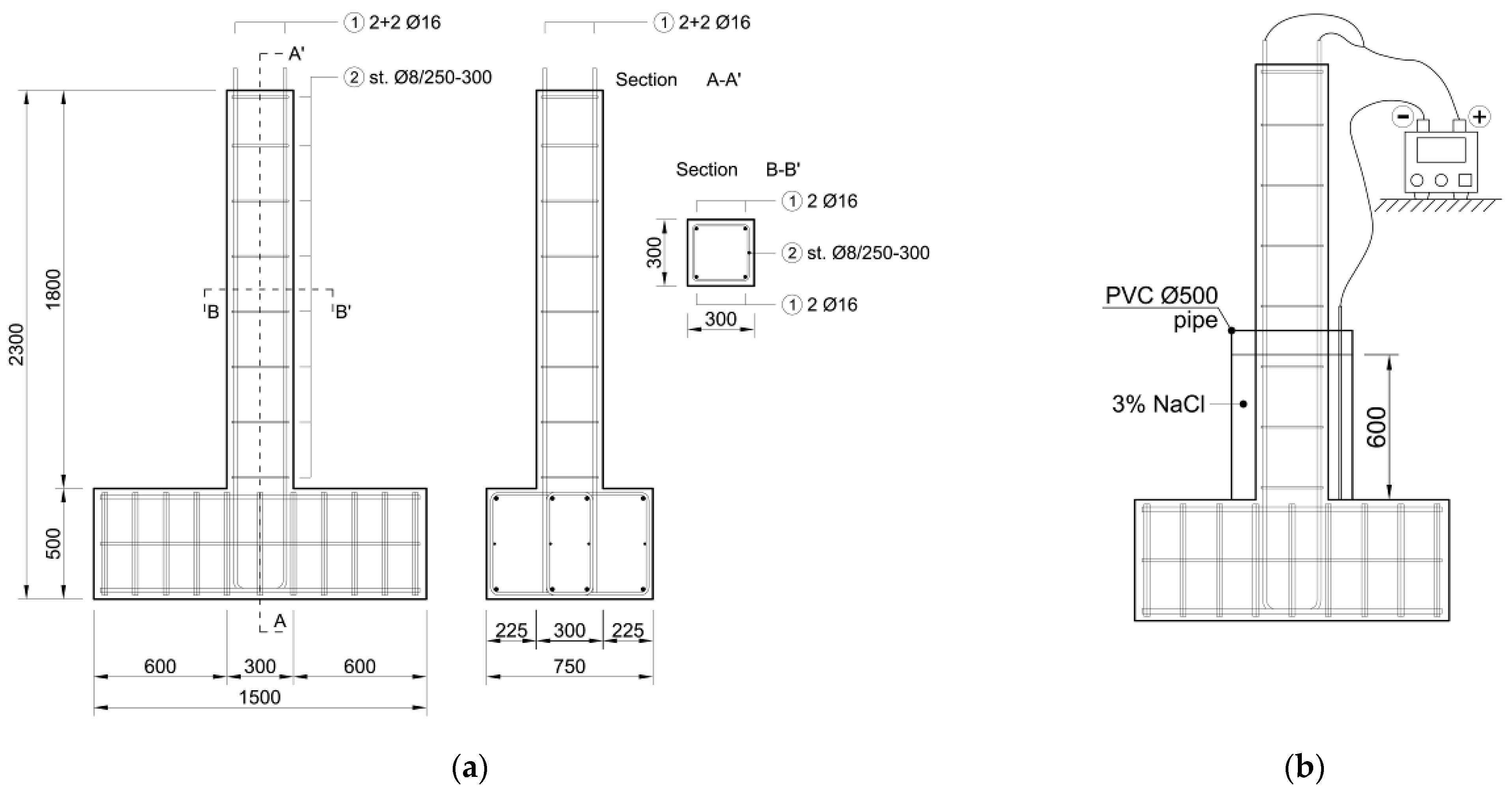
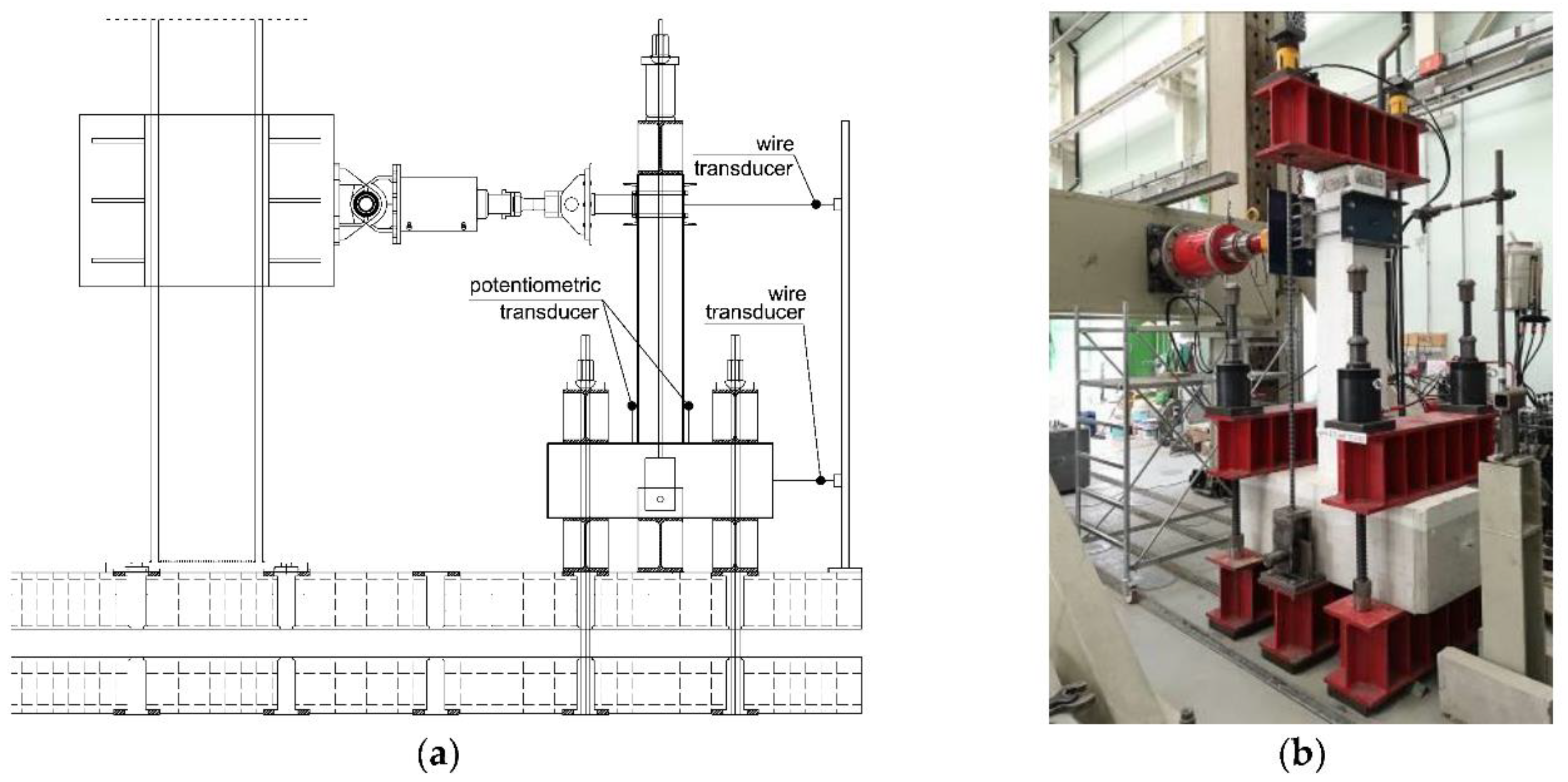
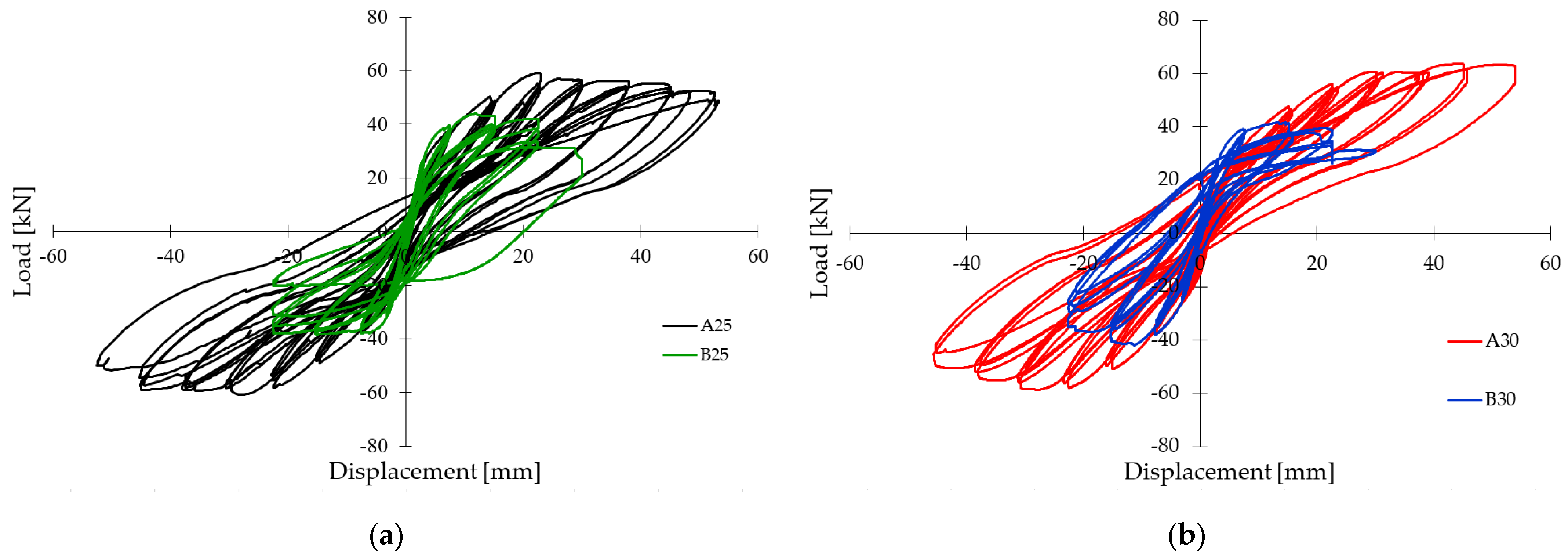

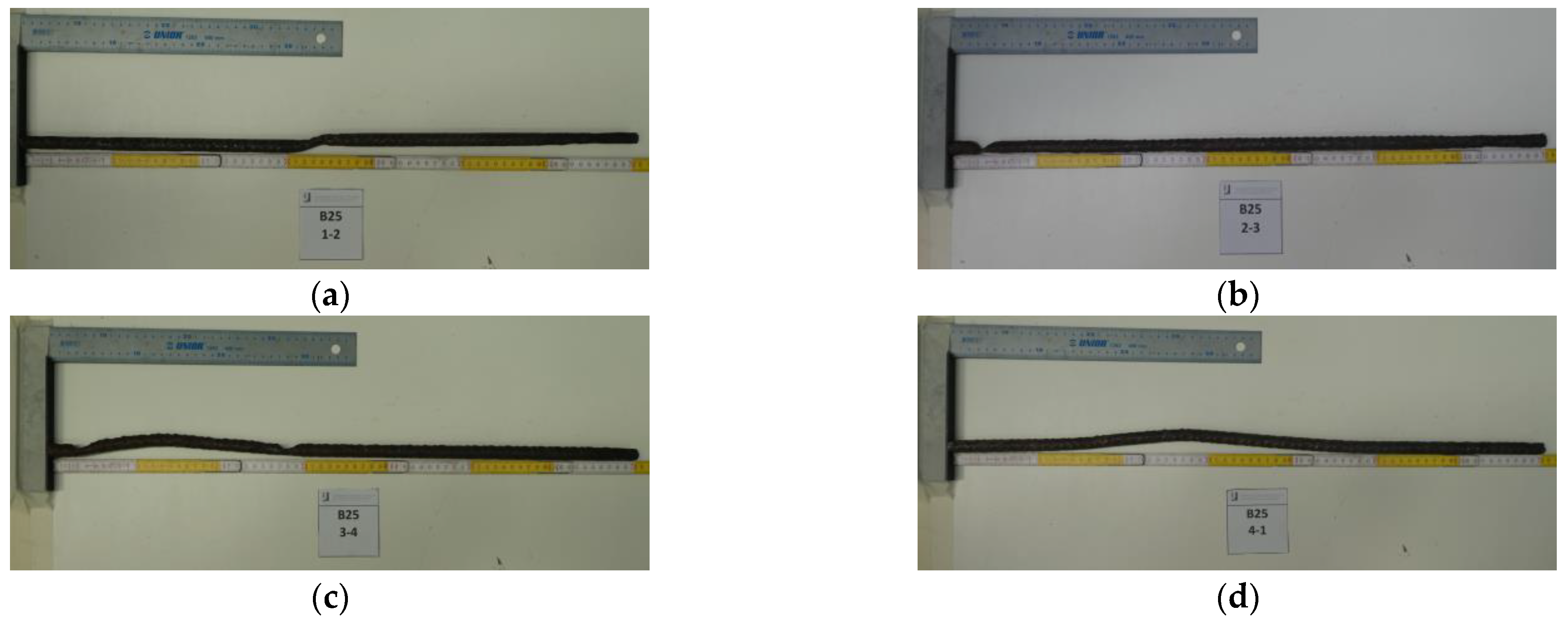
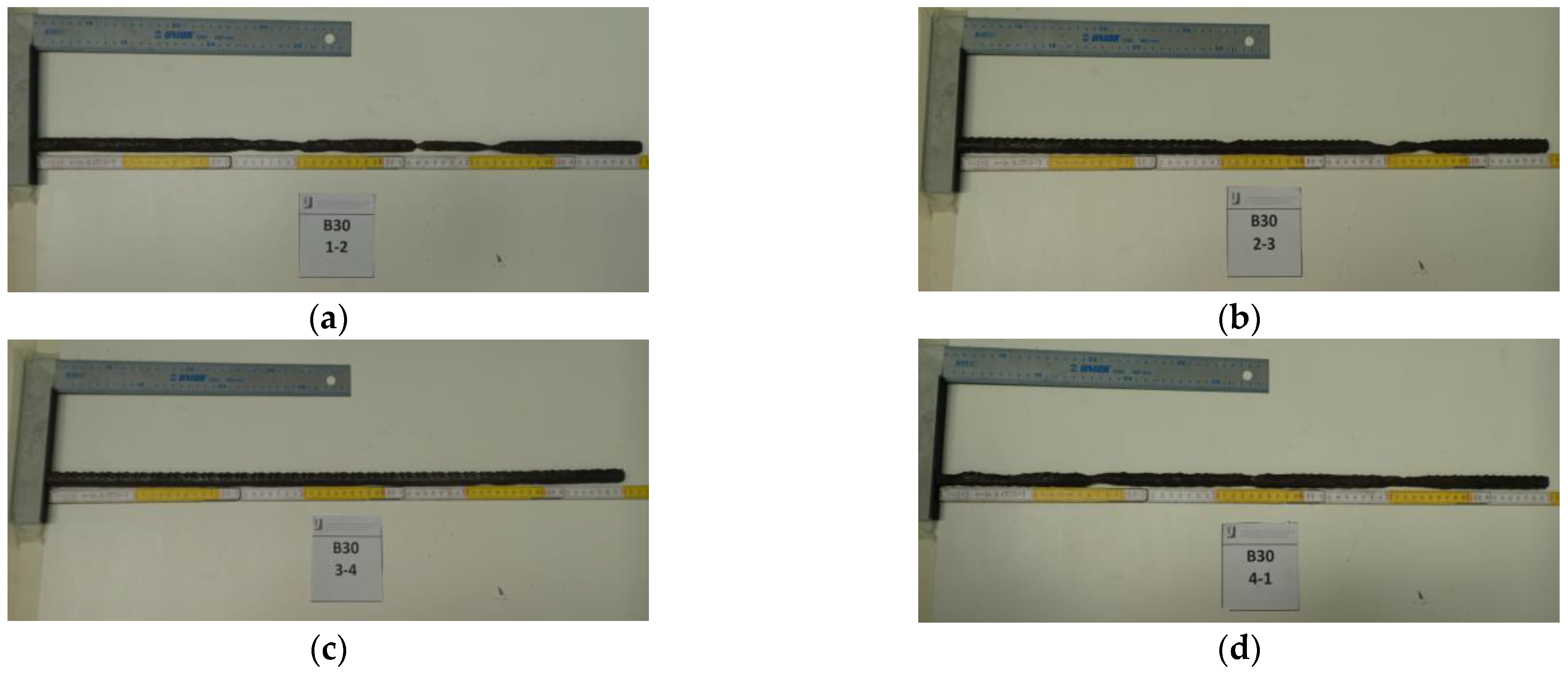
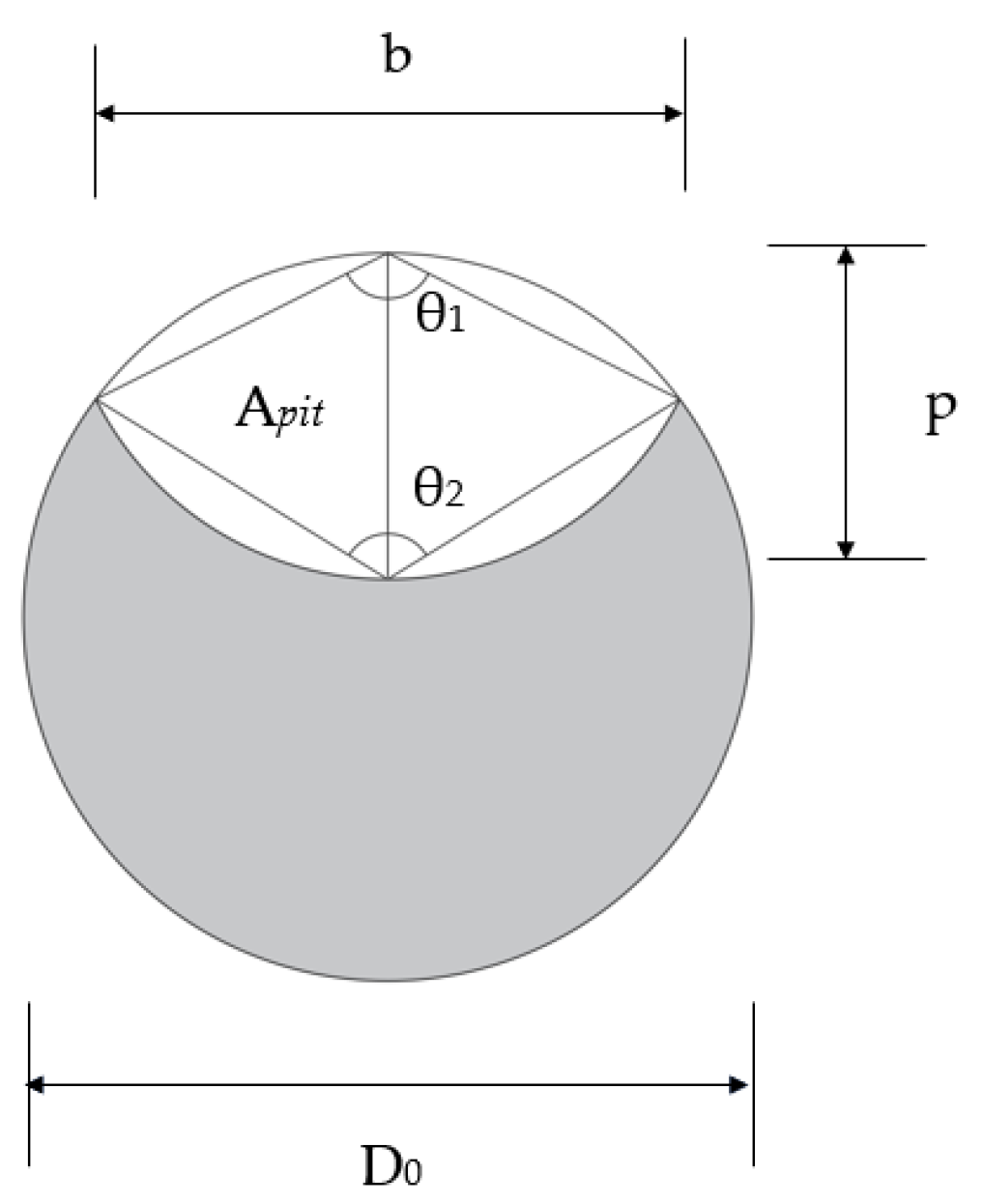
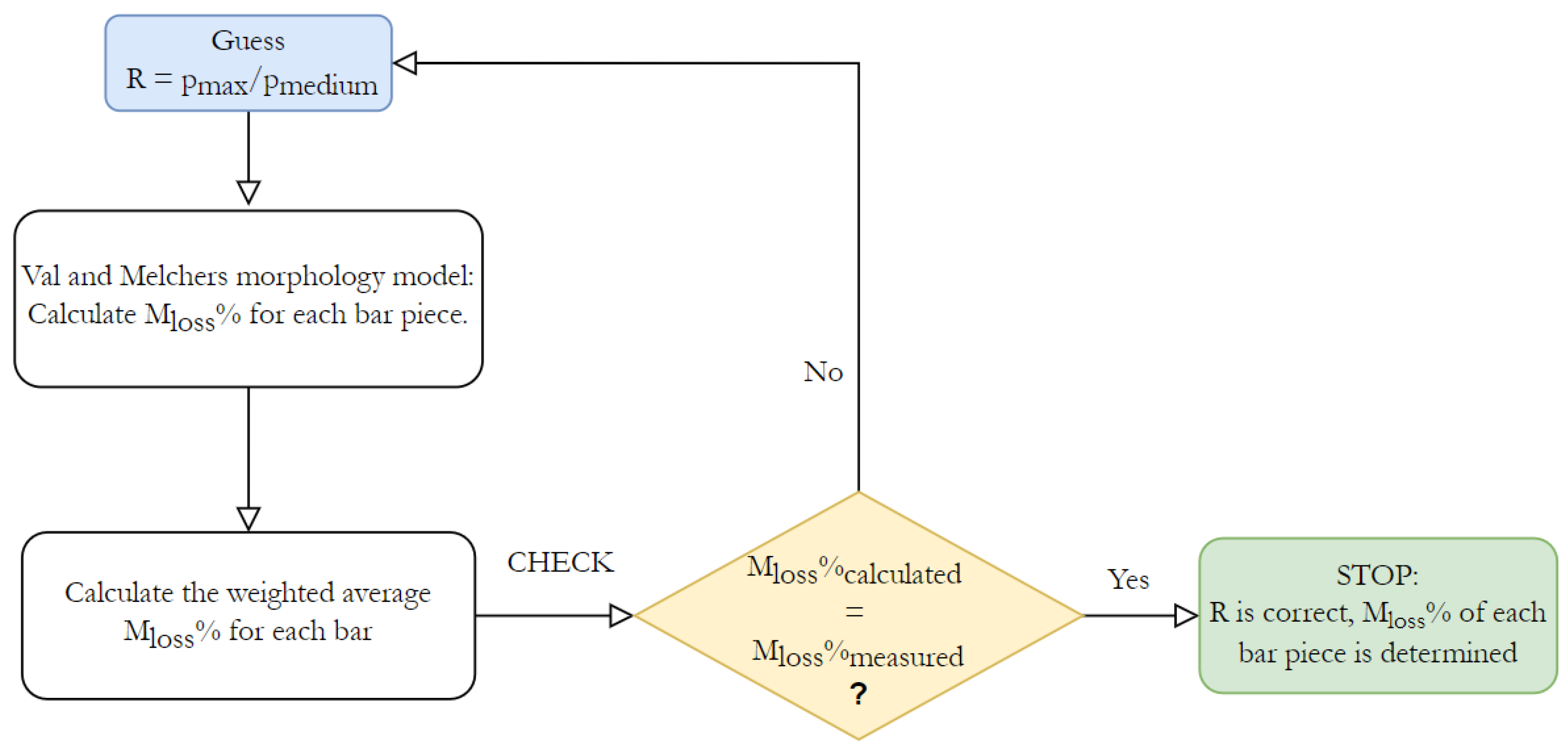

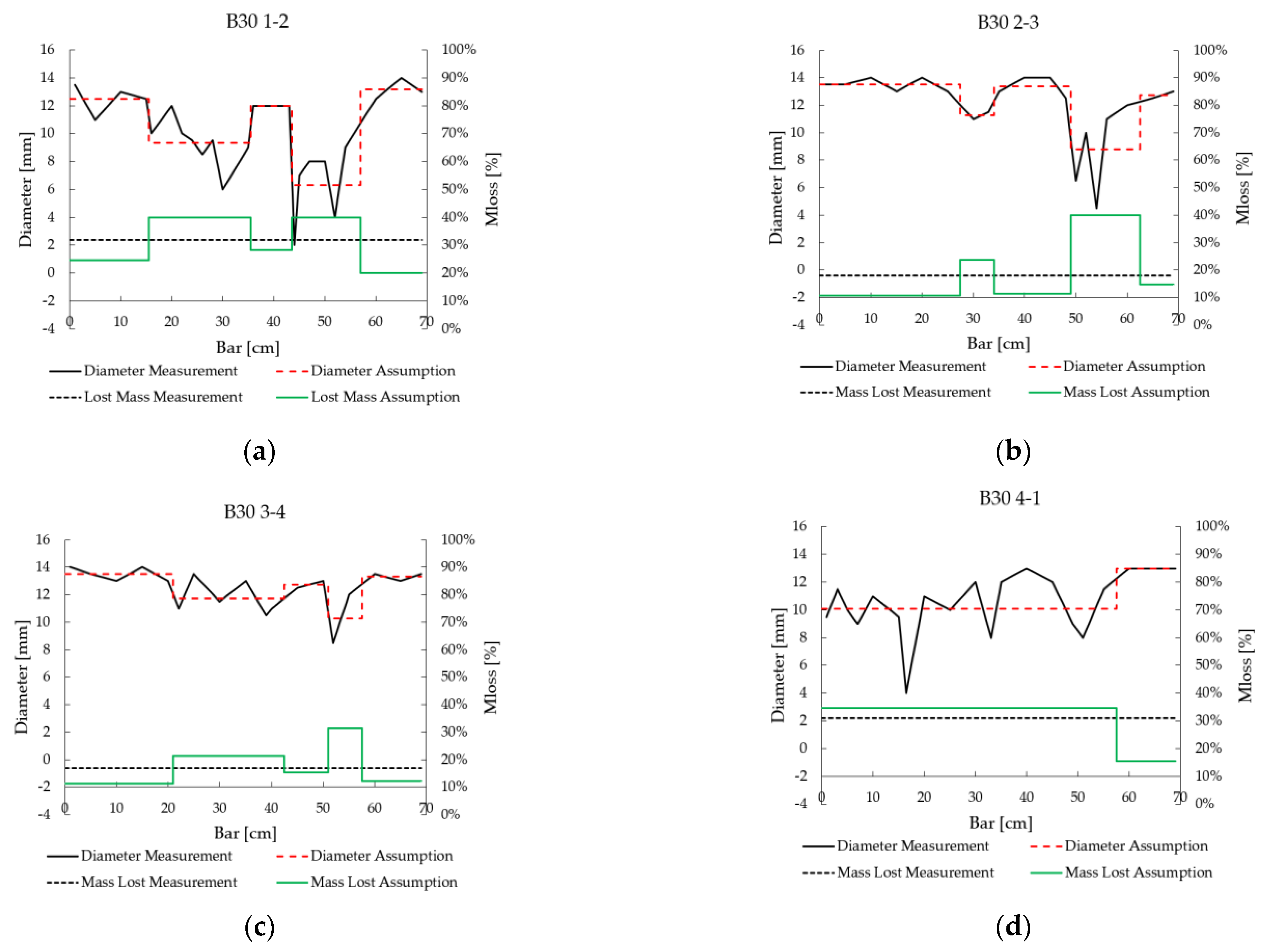

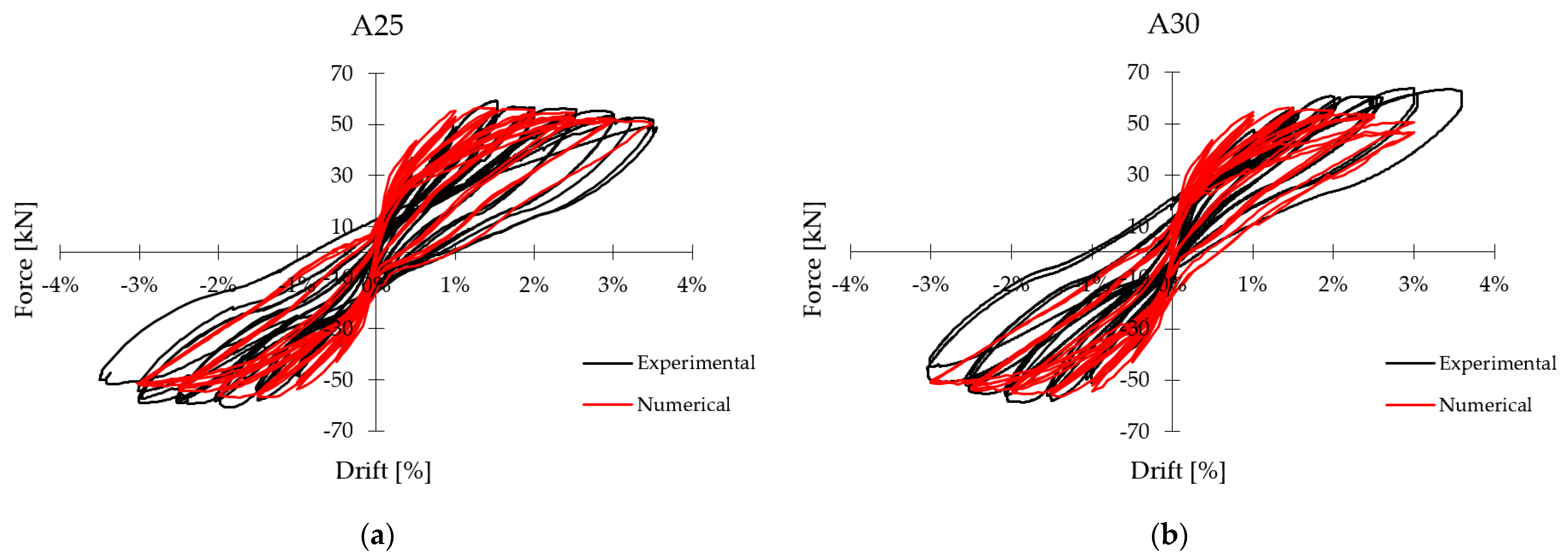
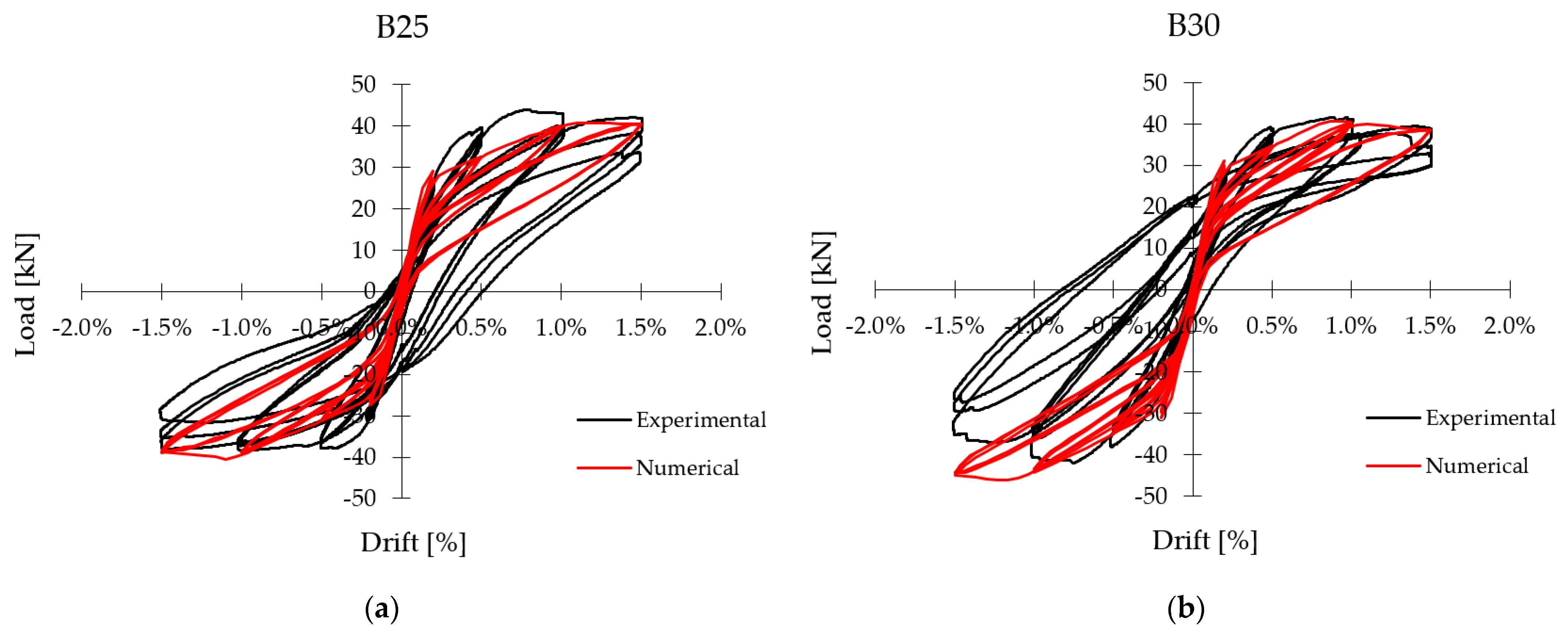
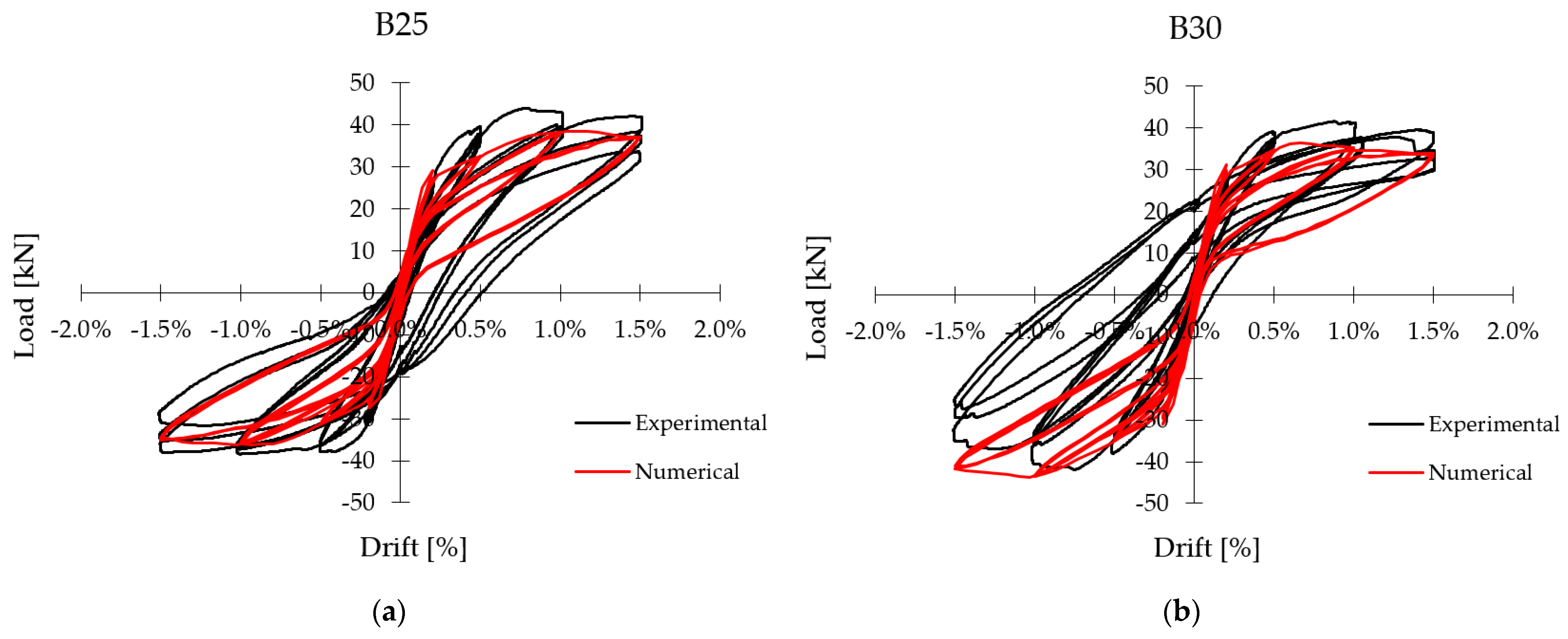

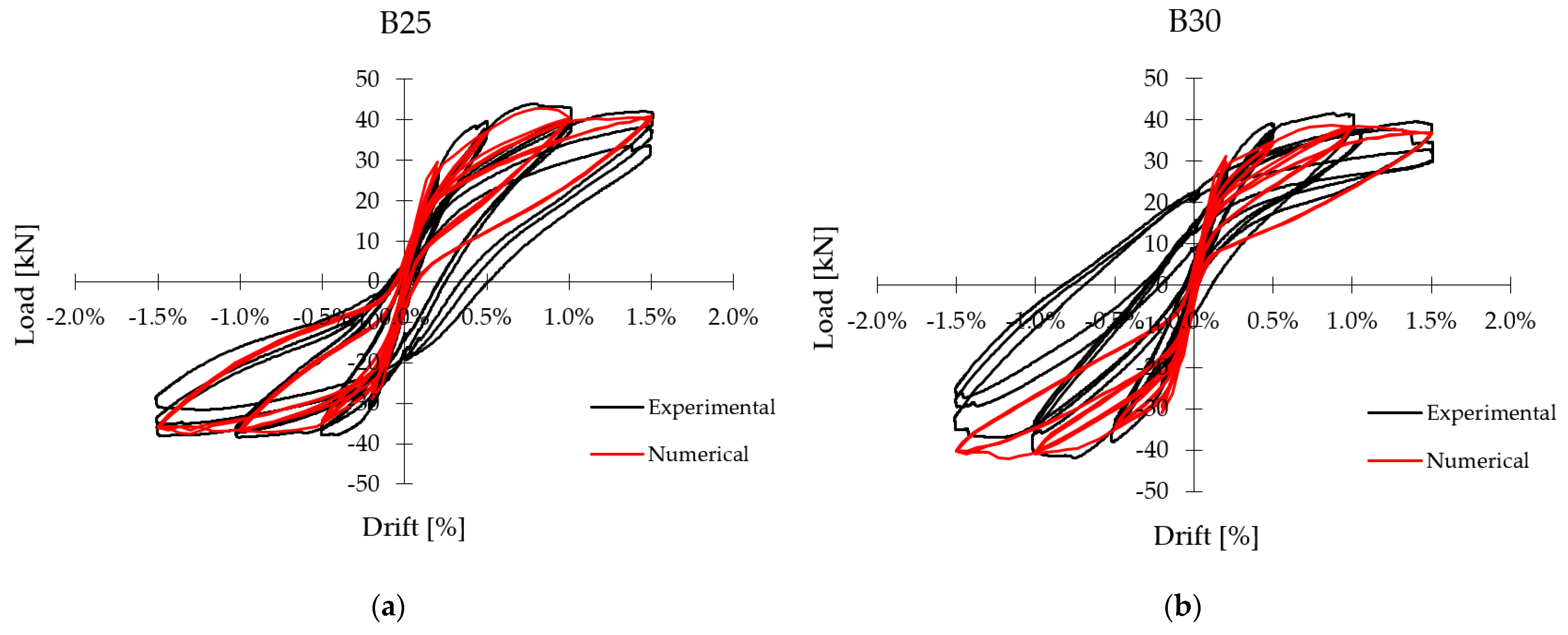
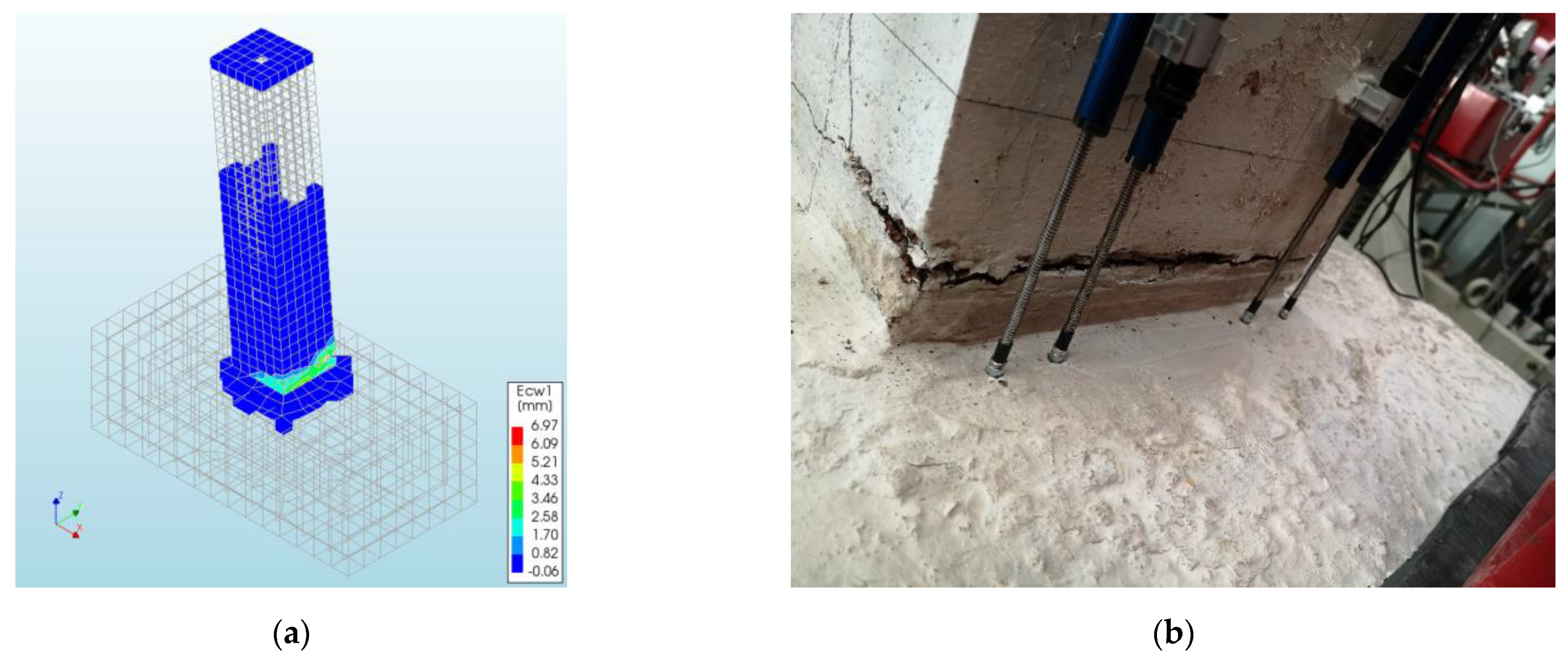
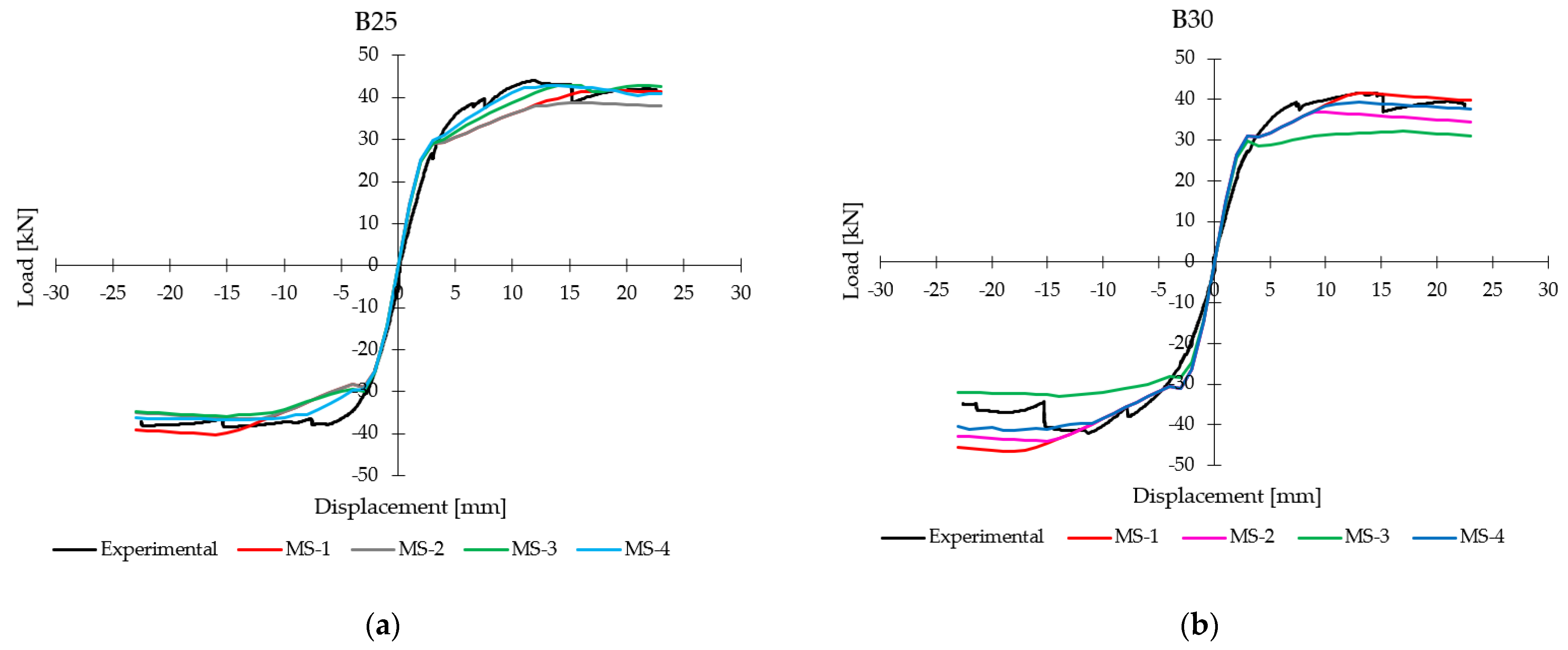
| Specimen | Stirrups Spacing | Corrosion |
|---|---|---|
| A25 | 250 | - |
| B25 | ▪ | |
| A30 | 300 | - |
| B30 | ▪ |
| Steel | Esteel | Density | fyielding | b0 | R0 | A1 | A2 | A3 | A4 |
|---|---|---|---|---|---|---|---|---|---|
| MPa | kN/m3 | MPa | - | - | - | - | - | - | |
| B450C | 210,000 | 78 | 520 | 0.0062 | 20 | 18.5 | 0.15 | 0.01 | 7 |
| Column | Bar | Lenght | Un-Corroded Weight | Corroded Weight | Mloss% |
|---|---|---|---|---|---|
| [mm] | [g] | [g] | - | ||
| B-25 | 1-2 | 705 | 1114 | 840 | 25% |
| 2-3 | 698 | 1103 | 810 | 27% | |
| 3-4 | 710 | 1122 | 835 | 26% | |
| 4-1 | 710 | 1122 | 920 | 18% | |
| B-30 | 1-2 | 700 | 1106 | 750 | 32% |
| 2-3 | 696 | 1100 | 900 | 18% | |
| 3-4 | 700 | 1106 | 915 | 17% | |
| 4-1 | 696 | 1100 | 760 | 31% |
| Column | Bar | Mloss% | fy,uniform | εy,uniform | fy,pitting | εy,pitting |
|---|---|---|---|---|---|---|
| - | MPa | - | MPa | - | ||
| B-25 | 1-2 | 25% | 334 | 0.16% | 261 | 0.12% |
| 2-3 | 27% | 319 | 0.15% | 240 | 0.11% | |
| 3-4 | 26% | 326 | 0.16% | 250 | 0.12% | |
| 4-1 | 18% | 386 | 0.18% | 333 | 0.16% | |
| B-30 | 1-2 | 32% | 281 | 0.13% | 188 | 0.09% |
| 2-3 | 18% | 386 | 0.18% | 333 | 0.16% | |
| 3-4 | 17% | 393 | 0.19% | 344 | 0.16% | |
| 4-1 | 31% | 289 | 0.14% | 198 | 0.09% |
| Column | Bar | Measured Mloss% | Pitting Factor | Piece Lenght | Piece Mloss% |
|---|---|---|---|---|---|
| [mm] | |||||
| B-25 | 1-2 | 25% | 1 | 115 | 27% |
| 200 | 14% | ||||
| 30 | 40% | ||||
| 285 | 16% | ||||
| 70 | 40% | ||||
| 2-3 | 27% | 1 | 22.5 | 12% | |
| 52.5 | 40% | ||||
| 300 | 29% | ||||
| 200 | 15% | ||||
| 115 | 35% | ||||
| 3-4 | 26% | 1 | 20 | 12% | |
| 250 | 40% | ||||
| 430 | 14% | ||||
| 4-1 | 18% | 1 | 275 | 13% | |
| 300 | 5% | ||||
| 125 | 22% |
| Column | Bar | Measured Mloss% | Pitting Factor | Piece Lenght | Piece Mloss% |
|---|---|---|---|---|---|
| [mm] | |||||
| B-30 | 1-2 | 32% | 2.6 | 155 | 25% |
| 200 | 40% | ||||
| 80 | 28% | ||||
| 135 | 40% | ||||
| 120 | 20% | ||||
| 2-3 | 18% | 6.5 | 275 | 11% | |
| 65 | 24% | ||||
| 150 | 11% | ||||
| 135 | 40% | ||||
| 65 | 15% | ||||
| 3-4 | 17% | 5.9 | 210 | 11% | |
| 215 | 21% | ||||
| 85 | 15% | ||||
| 65 | 31% | ||||
| 115 | 12% | ||||
| 4-1 | 31% | 4.8 | 575 | 35% | |
| 115 | 15% |
| Specimen | Max. Load (+) | Drift at Max. Load (+) | Δload (+) | Max. Load (−) | Drift at Max. Load (−) | Δload (−) | |
|---|---|---|---|---|---|---|---|
| kN | kN | ||||||
| A25 | Exp. | 59.2 | 1.51% | −4.10% | −60.7 | −1.83% | −6.18% |
| Num. | 56.8 | 1.30% | −56.9 | −1.73% | |||
| A30 | Exp | 63.7 | 2.94% | −11.97% | −58.7 | −1.85% | −3.75% |
| Num | 56.0 | 1.43% | −56.5 | −1.43% | |||
| Specimen | Max. Load (+) | Drift at Max. Load (+) | Δload (+) | Max. Load (−) | Drift at Max. Load (−) | Δload (−) | |
|---|---|---|---|---|---|---|---|
| kN | kN | ||||||
| B25 | Experimental | 43.96 | 0.78% | −38.42 | −1.00% | ||
| MS-1 | 40.85 | 1.17% | −7.07% | −40.47 | −1.10% | 5.33% | |
| MS-2 | 38.58 | 1.10% | −12.25% | −36.20 | −1.03% | −5.76% | |
| MS-3 | 42.99 | 1.00% | −2.20% | −37.39 | −0.011 | −2.68% | |
| MS-4 | 42.77 | 0.80% | −2.70% | −37.53 | −1.30% | −2.32% | |
| Specimen | Max. Load (+) | Drift at Max. Load (+) | ΔLoad (+) | Max. Load (−) | Drift at Max. Load (−) | ΔLoad (−) | |
|---|---|---|---|---|---|---|---|
| kN | kN | ||||||
| B30 | Experimental | 41.65 | 0.88% | −42.00 | −0.75% | ||
| MS-1 | 40.76 | 0.93% | −2.12% | −46.15 | −1.23% | 9.88% | |
| MS-2 | 36.33 | 0.67% | −12.76% | −43.82 | −1.03% | 4.32% | |
| MS-3 | 31.51 | 1.00% | −24.34% | −35.76 | −1.10% | −14.87% | |
| MS-4 | 38.64 | 0.87% | −7.22% | −42.11 | −1.17% | 0.25% | |
Publisher’s Note: MDPI stays neutral with regard to jurisdictional claims in published maps and institutional affiliations. |
© 2021 by the authors. Licensee MDPI, Basel, Switzerland. This article is an open access article distributed under the terms and conditions of the Creative Commons Attribution (CC BY) license (https://creativecommons.org/licenses/by/4.0/).
Share and Cite
Molaioni, F.; Di Carlo, F.; Rinaldi, Z. Modelling Strategies for the Numerical Simulation of the Behaviour of Corroded RC Columns under Cyclic Loads. Appl. Sci. 2021, 11, 9761. https://doi.org/10.3390/app11209761
Molaioni F, Di Carlo F, Rinaldi Z. Modelling Strategies for the Numerical Simulation of the Behaviour of Corroded RC Columns under Cyclic Loads. Applied Sciences. 2021; 11(20):9761. https://doi.org/10.3390/app11209761
Chicago/Turabian StyleMolaioni, Filippo, Fabio Di Carlo, and Zila Rinaldi. 2021. "Modelling Strategies for the Numerical Simulation of the Behaviour of Corroded RC Columns under Cyclic Loads" Applied Sciences 11, no. 20: 9761. https://doi.org/10.3390/app11209761
APA StyleMolaioni, F., Di Carlo, F., & Rinaldi, Z. (2021). Modelling Strategies for the Numerical Simulation of the Behaviour of Corroded RC Columns under Cyclic Loads. Applied Sciences, 11(20), 9761. https://doi.org/10.3390/app11209761







